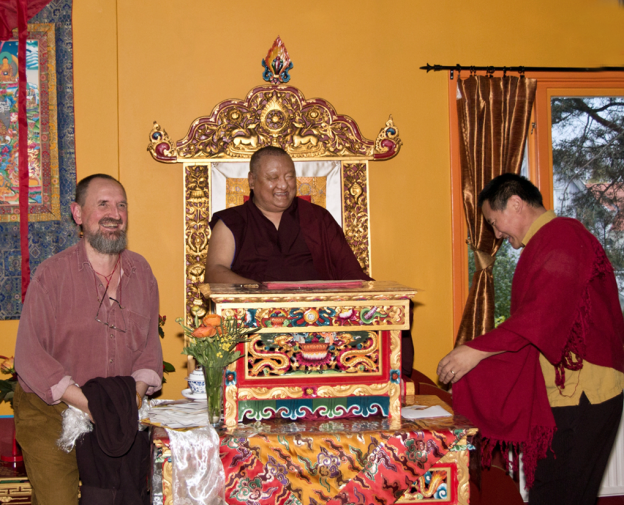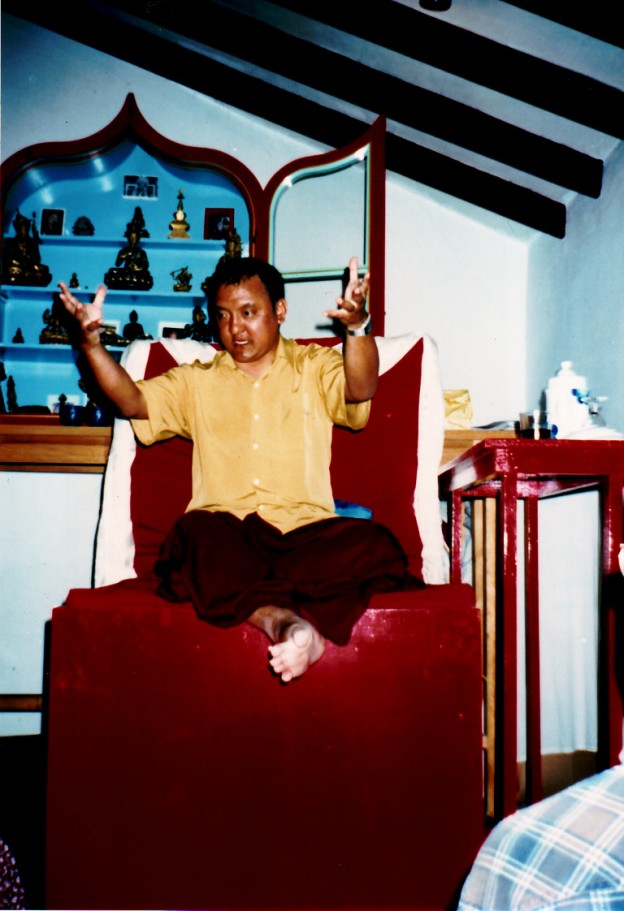In August 2009 HH Shamar Rimpoche visited the EC in Immenstadt, Germany, and gave a historic teaching on the Great Seal Wishes of the Third Karmapa. We experienced rich, highly intellectual and one-pointed teachings. HH himself expressed this state of simpleness, one-pointedness and of course non-meditation. Happy those who discovered that this was not about the teaching but about the teacher showing the result himself. Thank You very much.
Author Archives: Fernando Schlottmann
Condolence
Startling news that H.H. Gyalwa Shamarpa Rinpoche has entered parinirvana at his Dharma Centre in Germany came as a great shock, filling us with sadness. Rinpoche’s very sudden and entirely unexpected passing is a tremendous loss to Buddhism, specifically to the Kagyu Lineage, and to a great many Dharma practitioners everywhere. It is as though the blackness of night has suddenly swallowed up our world.
Our sangha pray that Gyalwa Shamarpa’s enlightened activities and vast aspirations for the benefit of all beings continue to unfold, without interruption, and quickly reach fruition.
We wish to express our deepest condolences to Jigme Rinpoche, to Gyalwa Sharmapa Rinpoche’s other family members and to his extensive sangha.
May the sun of his next incarnation dawn as soon as possible!
Chökyi Nyima Rinpoche, Tsikey Chokling Rinpoche, Phakchok Rinpoche and Tulku Urgyen Yangsi Rinpoche
Rinpoche
June 11 2014
Dear Jigme Rinpoche, Chimey-la and all other family members of Shamar Rinpoche,
I am very shocked to hear about the sudden passing of Shamar Rinpoche. I am so sorry to hear this news.
Shamar Rinpoche and all my family are very close. He was especially close to my father Tulku Urgyen Rinpoche. Also my grandfather Lama Tashi Dorje feels very close to Shamar Rinpoche and I do as well.
From myself, Pundarika Foundation International and from the Tsoknyi lineage nuns, we send our deepest condolences.
We will all pray for his return.
My deep and respectful wishes,
Tsoknyi Rinpoche

Shamarpa in Stockholm
Shamar Rinpoche visited Stockholm and Karme Tenpe Gyaltsen for the first time in October 2012 and I was the lucky one to be the photographer. Rinpoche gave us Amitabha iniation and bodhisattva vows… our center was packed and it was a beautiful time. The picture you see is a relaxed moment after the initiation when Lama Chöphel of Yangpachen Europe (Hungary), Shamar Rinpoche and our Lama Tsultim Rinpoche had a good laugh. It is not the best of my pictures – pls see www.ktg.nu for that – but it is a dear picture – so capturing the spirit of the day. Bless you Rinpoche!
72076 Tübingen
I was in Renchen-Ulm for a course with Shamar Rinpoche, the second last.
After I waked up and walk on the terasse, I suddenly look up to the window in second floor.
Rinpoche was standing there an simply smile.
I feel he is the great incarnation of Buddha Amitabha.
The smile was like the description in the meditaion text: he shines like a sun as if there are thousands of suns.
I am a simple person with family. May I have time to improve and continue my practices for the help of other people. In memorie to the great lama shamar rinpoche

Shamar Rinpoche in Karma Guen 1994
In the early 1990es, we were blessed by Shamar Rinpoche’s unannounced, informal visit to Karma Guen. After seeing the future stupa sight and the surroundings of the Center, he did prayers in our tiny meditation hall and gave us a teaching on the Dharma.
I would like to express my gratitude to everyone who joined me in supporting Mrs Mariam Yahia Ibrahim in her fight for freedom.
Thanks to all of you speaking out her death sentence has been reversed and she and her newborn daughter are said to be reunited with her family in the coming days.
This will not truly be a victory until she has actually been released. We must continue to fight for her and all the women in the world who find themselves under oppression and their human rights being violated.
This wonderful news for Mrs Ibrahim shows when we speak out the world listens.
Shamar Rinpoche
A letter of support for Mrs Miriam Yehya Ibrahim
I would like to show my support for Mrs Miriam Yehya Ibrahim of Sudan.
Her wrongful imprisonment and sentence to public whipping and death goes against international standards of Human rights. This is not an internal issue of one country but one that affects all of humanity.
I ask that everyone including world leaders and Nobel peace prize winners to join me in insisting on her right to have control over her own body and demanding her immediate release from prison in order to reunite her with her family.
Shamarpa Rinpoche
The Result of Shamatha and Vipashyana
Seven : The Result of Shamatha and Vipashyana
The result of accomplishing shamatha is that mind becomes completely pure, that all the gross disturbing emotions are subdued and purified. The result of accomplishing vipashyana is that wisdom becomes completely pure. This means that basic ignorance is purified and removed, and disturbing emotions are also removed.
Another way to express the results of these two practices is by the removal of the two kinds of bondage or veils. One veil is to be trapped by concepts or neuroses. The other is to be trapped by ignorance or illusion, and therefore continuing to be reborn in samsara. Shamatha releases the veil of concepts and vipashyana liberates from the veil of ignorance. Another result is that shamatha removes attachment to phenomena. It overcomes hopes, doubts and worries. We hope to get what we want, but when we don’t get it, we worry. This comes from desire and attachment. The result of shamatha is that even if you try to achieve something, you never need to hope, doubt or worry, because attachment and desire have been overcome.
When you achieve true shamatha, there is also all the extraordinary play. From shamatha you achieve clairvoyance. You can see past lives and know the minds of others. But advanced meditators discourage us from playing with that, because there is a great risk of becoming attached to shamatha, and then our problems will increase. But if someone is strong enough, they can control it without attachment.
Devadatta was a cousin of the Buddha, and he was very wicked. He wanted to compete with Buddha, so he went to an advanced student of Buddha, an Arhat named Kashyapa, to learn shamatha. Arhats have the fault that they cannot use their powers except while they actually meditate. In his post meditation he could not see Devadatta’s negative motivation. So he thought, “Before this man was very evil. Now he wants to learn meditation. I should teach him properly, so he may change.” So he taught him shamatha, and Devadatta learned it very well. He achieved a powerful level of shamatha, and then used his powers against Buddha. First he deceived the king of that area, and then split the sangha into two, taking the old king on his side. Then he encouraged the young prince to revolt against his father, and with his monks he attacked Buddha. He did all this because he was jealous of Buddha, and he used powers accomplished through shamatha. That is why teachers encourage their students to do shamatha for liberation, but then discourage them from going too far. Special disciples such as Bodhisattvas with pure motivation will not misuse these powers.
The result of vipashyana is quite straightforward.
It is liberation and enlightenment.
The Order for Practicing Shamatha and Vipashyana
Five : The Order for Practicing Shamatha and Vipashyana
Generally, first you practice shamatha and after that you practice vipashyana. That is according to the Theravada tradition. But in the Mahayana, Vajrayana or Mahamudra tradition, it is not always the case. Sometimes they can be practiced simultaneously depending upon the individual practitioner. Your teacher should decide what is best for you, as long as the teacher is qualified in meditation.
One result of accomplishing shamatha is to know the minds of other beings. An accomplished teacher uses this ability to see what is best for their students. The method for doing this is the same as remembering the past, but here the teacher concentrates on the minds of others instead of on themselves. This is of course easy to say, but not so easy to do.
The normal order is to practice shamatha first then vipashyana, and it is best to do it this way.
Six : The Levels of Shamatha and Vipashyana
How to unite shamatha and vipashyana? It is possible to practice vipashyana without shamatha, but it is not advisable. You can go to a teacher and receive vipashyana instructions, and use your confidence and intelligence to accomplish the practice. Even though you can have direct experience of the nature of things, this experience will not become stable without first accomplishing shamatha. This is also true for practicing vipashyana without a shamatha practice that has become natural. It is comparable to a candle in the wind; although it provides light, it is very unstable. Similarly, you can have a direct experience through vipashyana, but without shamatha it remains unstable.
On the other hand, if you practice only shamatha without ever practicing vipashyana, you cannot become liberated from samsara. This was explained before, in the obstacles to meditation. Accomplish shamatha without practicing vipashyana carries the risk of being reborn in long-lasting meditation states, which are still in the domain of ego. In the final achievement of shamatha, mind is in a profound rest. It is deeply relaxed, beyond what we can now imagine. But ignorance, the root of illusion, has not yet been removed. That explains the necessity for practicing both shamatha and vipashyana.
How can we unite them into one practice? This is not something we can accomplish yet. You can work with them in certain ways, but it is only when you have achieved the highest level of shamatha, that you can unite them completely. The ninth level is to rest the mind in equanimity. At that point, vipashyana develops naturally, and the two practices become one.